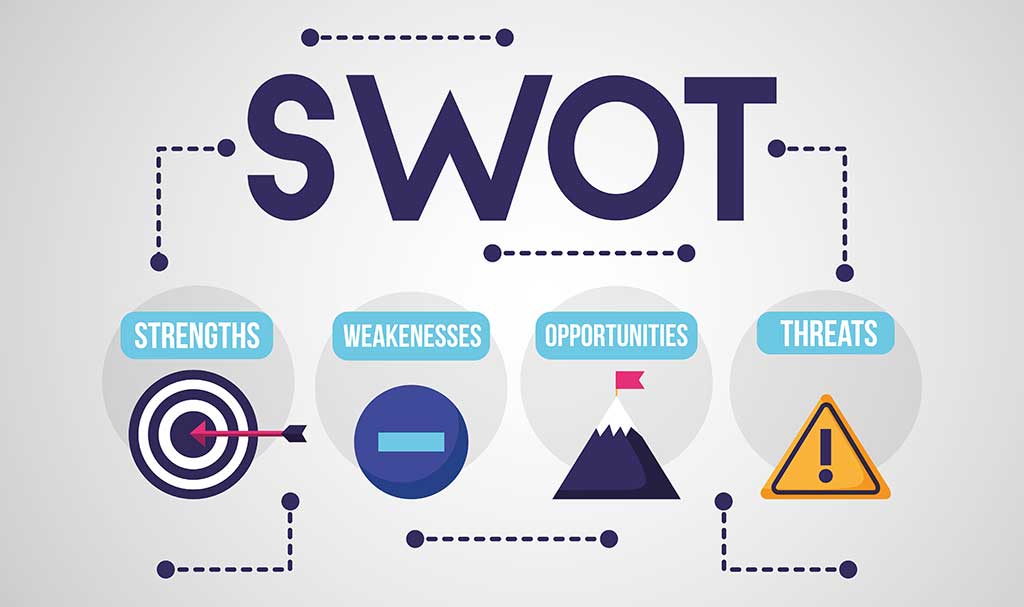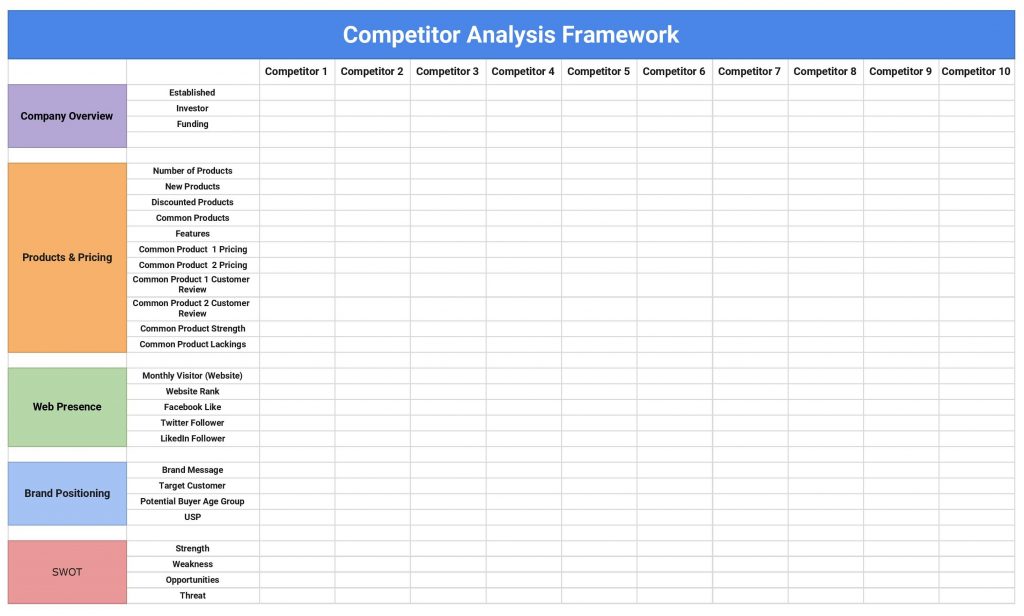
10 Secrets to Conduct a Successful eCommerce Competitor Analysis
Competitor analysis is crucial in eCommerce because it helps businesses understand their position in the market and identify growth opportunities.
Today's free market and access to the internet have made eCommerce business easier and more lucrative for everyone. As a result, for every product you sell, you'll find 10 other websites selling the same one.
The easier it is to start an eCommerce business, the harder it is to get on the top.
But competitor analysis can help!
So, in this guide, we will walk you through a definitive guide on how an eCommerce business can perform competitor analysis to stay ahead of its competitors.
What is eCommerce Competitor Analysis- Let's Understand the Concept
Competitor Analysis is a broad term that consists of many different tasks. However, in short, it can be defined like this –
Competitor analysis is a strategic research process to identify and evaluate your competitors' products, growth, and marketing strategy.
Though the idea of competitor analysis is pretty straightforward, the process, on the other hand, is not that simple. There is no foolproof guideline that will make your competitor analysis the best one. Instead, it depends on the industry your business is in.
If you are in an eCommerce business, with a good eCommerce competitor analysis, you will have the chance to get a more clear understanding of your competitors, and what they are trying to do. Then you'll be able to make better decisions for your next marketing strategy.
Related Resource: 10 Actionable eCommerce Business Tips for Struggling Entrepreneurs.
Why is Competitor Analysis a Must for Your eCommerce Business?
Today, eCommerce means cutthroat competition. You can't afford to lose focus for a single moment. If you don't keep tabs on your competitors regularly, suddenly one day you'll start losing customers and you won't even know why.
Here are a few more reasons to perform eCommerce competitor analysis regularly:
- Identifying Market Trends: By analyzing your competitors, you can gain valuable insights into emerging market trends, consumer preferences, and changing customer behaviors. This information helps you stay updated and adapt your strategies accordingly to meet evolving customer demands.
- Understanding Competitive Landscape: Competitor analysis provides a comprehensive view of your industry's competitive landscape. It enables you to identify who your direct and indirect competitors are, what products or services they offer, their pricing strategies, marketing tactics, and strengths and weaknesses.
- Benchmarking Performance: Analyzing your competitors' performance allows you to benchmark your own business against them. By comparing key metrics such as sales, market share, customer satisfaction, and online presence, you can assess your relative strengths and weaknesses.
- Uncovering New Opportunities: Competitor analysis can reveal untapped market opportunities that you may have overlooked. By studying your competitors' customer feedback, reviews, and social media presence, you can identify gaps in the market, customer pain points, or areas where your competitors fall short.
- Enhancing Marketing and Advertising Strategies: Analyzing your competitors' marketing and advertising efforts provides valuable insights into successful campaigns, messaging tactics, target audience segments, and channels that resonate with customers. By understanding what works for your competitors, you can refine your own marketing strategies, optimize your messaging, and allocate your resources effectively to reach and engage your target audience.
For an eCommerce business, performing regular competitor analysis doesn't just give one an edge over competitors, it is a must-do to stay in the race and make a constant profit from your business.
10 Effective Tips to Conduct a Winning eCommerce Competitor Analysis

The first thing that needs to be done when you decide to perform competitor analysis on a regular basis is to create a checklist. This checklist will include all the different aspects that you will look into, every time you perform a competitor analysis:
- Identify Your Direct and Indirect Competitors
- Research the Products Your Competitors are Offering
- Keep an Eye on Your Competitors' Budgets
- Analyze Your Competitor's Content Strategy, Quality, and Reach
- Measure Your Competitors' Brand Positioning
- Understand the Social Media Presence
- Find out Your Competitors' Mediums for Advertising
- Get a Clear Picture of Your Competitors' Marketing Strategy and Growth
- Conduct a SWOT Analysis of Competitors
- Create a Competitor Analysis Framework
Note: Before jumping into the tips, let us share the essential tools that you'll require while analyzing your competitors.
Essential Tools & Websites for Competitor Analysis
While doing a Competitor Analysis for your eCommerce business you'll need to use some tools often. Here's a list of tools that you need to have some idea about:
a) Google
There is no better place to find information on a topic than Google. With the right keyword, it's possible to find useful insights that will help you perform a better competitor analysis.
b) Social Media
Social Media is the new Television for advertisement, except it's even better! You need to have an apt understanding of how different social media platforms work to perform better competitor analysis.
c) Youtube
YouTube is another crucial platform that you need to get a hold of for competitor analysis. It can provide insights that you will have a hard time finding on any other platform.
d) Indeed or a Similar Job Site
You can use job sites for better competitor analysis. How? We'll explain later!
e) Quora
If used properly, Quora can be one of the best tools to find potential competitors, find new products, and many more!
f) SimilarWeb
SimilarWeb can effectively present your market share and comparison of your competitors, which is one of the most important parts of competitor analysis.
g) Moz, SEMrush, or Similar
Content is king (if it is SEO optimized). Keyword research tools can provide you with important data on your competitors and can tell you if it's time to move on!
Now let's show you the steps to conduct an effective competitor analysis-
1. Identify Your Direct and Indirect Competitors
You can't possibly analyze your competitors without knowing who they are, can you? Identifying your competitors can be a tricky thing to do. But we're here to help!
There are quite a few ways you can find your competitors. Everybody knows most of their direct competitors. But with more and more players coming into the market, it's hard to keep track.
Here's some way you can do that –
i) Google Search
Google Search is by far the easiest and most effective way to find your competitors. Simply search for the product you sell, unless you are using a VPN, most of the results will show local companies that sell the product.
This way, you can easily get an idea of your direct competitors. Top of the results are the most established players in the market. You should keep track of everyone within the first 3 pages at least.
ii) Facebook
Facebook is not a traditional search engine, yet you can get so much information from its search results. That's because of its vast user base. Every business has a Facebook page, and if you search using the product name or keywords like “Buy Product Name” you're likely to get some page that also sells the same product that you sell.
iii) LinkedIn
LinkedIn has gained enormous popularity among professionals. There's a good chance your competitors have also set their foot on LinkedIn. LinkedIn groups and LinkedIn answers can be a great resource for anyone to identify potential competitors.
iv) Youtube
YouTube, the most popular video publishing platform can also help you find competitors. The enormous popularity of YouTube has brought a lot of business here. You can search for your product on YouTube and find more than one competitor easily!
Read More: Elevate Your eCommerce Growth with Powerful Video Marketing Strategies.
v) Quora
Quora is mainly a knowledge-sharing platform. The way it works is very simple. Someone asks a question, and those who know the answer, respond.
But because this site allows sharing links along with the answer, many people find and answer questions related to their product and indirectly encourage people to visit their website. If you search on Quora using your product name, you'll get a lot of answers. If you read closely, among the answers, many will contain a link to their website. Find yourself some more competitors! Sigh!
2. Research the Products Your Competitors are Offering

Now you have the list of your competitors. It's time to research their products. You'll need to note down answers to the following questions –
- What are their products?
- Did they launch any new products?
- How many of the products are similar to yours?
- Does your product lack any features compared to theirs?
- What is the pricing of their products compared to yours?
- Do they have a discount ongoing?
- What are the products that they lack compared to yours?
Create a table using all these answers. The products analysis section of your competitor research is likely to be the most time-consuming but it can yield a great result. Product analysis often helps to decide how you should present your products and what areas you can improve. You can also get an idea if any scopes on the market are still untouched.
3. Keep an Eye on Your Competitors' Budgets
The eCommerce competition has become fiercer. To be successful, you need to have a comprehensive long-term strategy in place. Formulating a strategy can be easier if you can get to know the financial condition of your competitors. But is it possible?

Most of the small eCommerce websites are private. You can't possibly know their finances, right? But there is a way. There are quite a few websites that publish news on startup funding like TechCrunch & Crunchbase.
If you follow them regularly, there's a good chance you can get news on the funding your competitors are getting. That way you will know what you're dealing with and do your company budgeting accordingly.
4. Analyze Your Competitors' Content Strategy, Quality, and Reach
Content has always been an important way to connect with customers. Most websites have a blog, and so should you. Analyzing your competitor's content marketing strategy is important to understand their overall marketing strategy.
If your competitors are attracting more visitors compared to yours, it's time to upgrade the quality of your content and tweak your content strategy!
Subscribe to competitors' blogs and follow them regularly. Compare them against your content, if your content quality is not already better, it's time to put more focus on what you circulate to your customers!
It's important to keep track of how many visitors your competitors are getting. In the end, more visitors means more chances to convert them into buyers.
Similarweb is an excellent website to know the number of visitors to your competitor's website. You can also know how many of them are paid, and how many are organic.
5. Measure Your Competitors' Brand Positioning

Content your competitors are publishing, be it blog, website slider, PR, or paid ad can tell about how they are trying to portray their business as a brand, and what message they are trying to give to the customers.
By reviewing their messaging you can get an idea of the following –
- What phrases your competitors are highlighting most?
- How are they attracting their customers? Better pricing, product, or better experience?
- What are the USPs of your competitors?
- If you were to write one sentence about every one of your competitors what would that be?
Answers to these questions can give you a clear picture of what your competitors are trying to convey to the customers. It will also help you find your own voice in the crowd. Remember, if your website doesn't have something that distinguishes you from your competitors, you're bound to lose customers.
Having a strong USP (Unique Selling Point) is your ticket to sustain in today's market, especially in eCommerce.
6. Understand The Social Media Presence
Do you follow your competitor's social media channels? If not yet, you should. Social media is an integral part of eCommerce. It's the place where customers can directly connect with businesses. Comments on social media posts can reveal customers' feelings towards a certain company.
Social media ads are also something that you should look closely at. Social media ads often generate more direct sales than any other and it's easier to judge the result of the social media campaigns of your competitors. Even if you don't get to see the engagement, the number of likes, comments, and shares can tell a lot!
Read about: Promoting Your Brand on TikTok: Things to Consider.
7. Find out Your Competitors' Mediums for Advertising
The more they see you, the more they remember you, this is how human psychology works. Modern businesses do it efficiently by diversifying their presence. There are PPC, email marketing, search engines, social media, YouTube, and many more platforms where one can advertise.
You should closely monitor which media your competitors are using to reach out to customers and note it down. Competitor analysis for eCommerce is about finding your strengths and weaknesses more than that of your competitors.
To be in a strong position you should try to find out which channels they are advertising in and match them with better offers and visuals.
8. Get a Clear Picture of Your Competitors' Marketing Strategy and Growth
A better strategy means better results. A competitor's marketing strategy should be more clear to you than theirs. You need to keep track of every move they make, every content they publish, every ad they post, and every discount they offer.
A marketing strategy consists of a lot of things. A good content strategy, social media presence, and brand positioning combine into a good marketing strategy.
A good market strategy can ensure sustainable growth for an eCommerce website.
To get an idea of their overall marketing strategy you should use websites like SEMrush, or Moz. These websites can give you significant insights into the keywords your competitors are using to attract customers.
While it's relatively easier to track your competitor's marketing strategy, it's hard to track how much they are growing. But regular news on your competitors and their PR statements can give you an idea of their growth. Their website visitors and social media followers are also other indicators to consider while measuring their growth.
9. Conduct a SWOT Analysis of Competitors

After evaluating all the competitors thoroughly, you'll have an overall idea of all the competitors. It will then pave the way for you to conduct a SWOT analysis on individual competitors.
SWOT analysis is a strategic planning technique used to help a person or organization identify strengths, weaknesses, opportunities, and threats related to business competition or project planning.
– Wikipedia
So, there you go. This is what SWOT is all about. There are four questions you need to know the answer before performing a SWOT analysis.
- What are the strengths of your competitor?
– This answer needs to include things that your competitor is known for or good at. - What are the weaknesses of your competitor?
– You'll have to find out what their client complains about the most. It can be customer service, slow shipping, overpricing, or anything that a customer can have a problem with. - What are the opportunities your competitors create for you?
– In this case, you'll have to find out what opportunities your competitors create for you. For instance, look out for any sudden change, a price increase something that you can exploit. - What are the threats to your business by our competitors?
– The question is rather self-explanatory. Identify the threat your competitor poses to your business.
After performing the SWOT analysis, you'll find some real gems of insights. SWOT analysis uncovers very useful data. You can then use that data efficiently to enhance your strategies accordingly.
10. Create a Competitor Analysis Framework
A Competitor Analysis framework is a model to present data that you gather through an eCommerce competitive analysis. It helps you represent data in an easily understandable way. Below is a picture of a Competitor analysis framework.
You can follow this competitor analysis framework to gather all the information that you have collected for your eCommerce business.

FAQs on eCommerce Competitor Analysis
eCommerce competitor analysis is vital because it allows you to stay ahead of the game by understanding your competitors' strategies, market trends, and customer preferences. It helps you identify untapped opportunities, optimize your pricing, marketing, and product offerings, and ultimately gives you a competitive edge in the fast-paced eCommerce industry.
When it comes to eCommerce competitor analysis, identifying your main competitors is crucial. Start by researching keywords related to your niche and see which businesses consistently appear in search results. Additionally, explore popular marketplaces and social media platforms to find competitors with a similar target audience.
To perform a winning eCommerce competitor analysis, there are several key metrics to consider. Pay attention to aspects such as sales figures, market share, customer reviews, pricing strategies, website traffic, social media engagement, and customer satisfaction.
Analyzing your competitors' marketing strategies is essential for success. Start by examining their online advertising campaigns, social media presence, content marketing efforts, and email marketing tactics.
There are various tools available to support your eCommerce competitor analysis journey. Popular options include SEMrush, Ahrefs, SimilarWeb, and Google Analytics. These tools offer valuable data on keyword research, website traffic, backlinks, and competitor analysis.
How to Perform an eCommerce Competitor Analysis- Key Takeaways for You
We hope, with the help of this guide, you can perform a competitor analysis by yourself. It is important to remember that the purpose of competitor analysis is not how your competitor is doing in the market but how they are doing compared to you. If you can do it well, it can open doors of possibility and help you dodge many bullets (not literally!) from your competitors.
So, here is a quick recap for you:
- Find out who your competitors are
- Research their content strategy, quality, and reach
- Understand their social media presence
- Conduct a SWOT analysis of your competitors
- Use different tools like Similar Web, Moz, and SEMrush for eCommerce competitive analysis
- Use the framework that we have provided in this blog to plan your strategy to beat your competitors.
Competitor Analysis is one of the crucial parts of an effective eCommerce business plan. The right roadmap guides your eCommerce activities and ensures you stay focused on your long-term vision.
If you have any feedback related to this blog on eCommerce competitor analysis, you can let us know in the comment box below. We would love to hear from you.